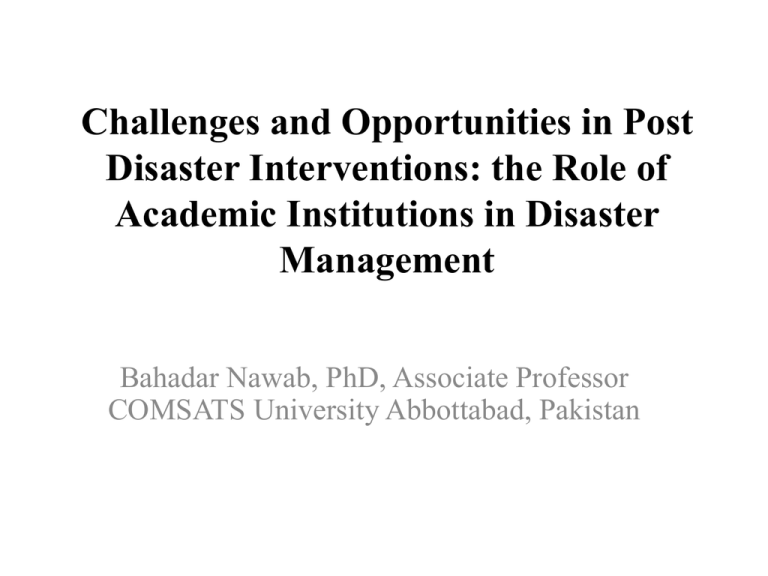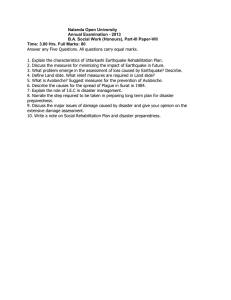Challenges and Opportunities in Post Disaster Interventions: the Role of
advertisement

Challenges and Opportunities in Post Disaster Interventions: the Role of Academic Institutions in Disaster Management Bahadar Nawab, PhD, Associate Professor COMSATS University Abbottabad, Pakistan Scope of Presentation • Discuss the strength and weakness of different stakeholders in post disaster situation • Explore opportunities where the academia and research institutes can contribute to overcome some of those weaknesses and possibly introduce a new approach to relief, rehabilitation and reconstruction interventions Introduction • Due to its geophysical and geopolitical situation, Pakistan is prone to frequent natural and man-made disasters and crises that continuously engage the government, humanitarian and relief agencies • The five major disasters (2005 earthquake, 2008 Swat IDPs and 2010, 11, 12 Flood) in the recent years of 21st century caught the attention of national and international community • Along with so many positive aspects, these disasters also exposed many institutional, managerial, financial, technical issues and research loopholes in the emergencies, relief, rehabilitation and reconstruction efforts of government, donors, I(NGOs) and politicians Introduction • Response to disaster are often inadequate as complex situations demand the need for coordinated and complex responses • Therefore, humanitarian assistance after disaster has become a topic of academic, practical, and political concern Relief, Rehabilitation and Reconstruction Approaches • From the 1960s onward, humanitarian action was based on a linear model… focusing on relief assistance, and when the disaster/conflict was over, development assistance would then be provided • In the 1980s, the continuum model of relief and development was formulated, bringing about the concept of rehabilitation, which bridges the gap between relief and development activities Relief, Rehabilitation and Local Participation • The question is, how to effectively carry out relief and rehabilitation? • Different approaches are being used, however studies such (De Zeeuw 2001; Anderson 1999; Nyheim, Leonhardt, and Gaigals 2001; Quinn 2002) take note of local capacities • Their focus has remained “deductive” and allowed international organizations to determine opportunities for intervention by the recipient state and civil-society organizations in relief and rehabilitation, instead of the other way around Disasters in Pakistan and CIIT Abbottabad 2005 earthquake Swat IDP’s 2010-11-12 Flood COMSATS Abbottabad and Flood 2010 Quick response Constitute Relief & Rehabilitation Committee Fund raising from Faculty and Students Relief Camps at the Affected Areas CIIT Initiatives Adopt a family • Rs. 8000 monthly support for 10 months • self, local, and foreign donors Adopt a student • Approx. 1000 students from affected areas • Self, local, and foreign donors for 1 years Adopt a village • Water, health, sanitation, education, renewable energy • Use same villages as research centers Evaluation of Several Mega Project • Evaluation Action Against Hunger (ACF) project of humanitarian support to conflict and flood affected population of KPK, Pakistan • Evaluation of USAID project in flood affected areas of Punjab and KPK on agriculture inputs and Cash for Work • WATSAN component in the Mission of the Embassy of Kingdom of Netherlands for Endline Evaluation of Partnership for Development of Allai • Evaluation of FAO intervention carried out under the Central Emergency Response Fund (CERF) in NWFP and Baluchistan provinces, Pakistan Lesson Learned from Post Disaster Intervention of CIIT • Research shows that the interventions in the disaster struck areas were not cost effective • Most of the donors money disappeared as an administrative cost and the affected and needy people got very little • Most of the interventions were without proper need assessment and not target oriented • The assistance provided was not according to the needs, expectation and requirement of the affected population Lesson Learned from Post Disaster Intervention of CIIT • The donors and the implementing partners could not design and implement the beneficiaries selection criteria, therefore, the powerful and resourceful people get the maximum share and the poor people are further marginalized • The quality of the intervention is usually poorly selected and in most cases not relevant to the environment and culture of the affected population Lesson Learned from Post Disaster Intervention of CIIT • Most of the interventions are not based on any research and scientific survey • The academia and research centers are in most cases not consulted and involved in relief and rehabilitation stage after disaster • The rehabilitation phase is usually started without proper identification and understanding of gaps Lesson Learned from Post Disaster Intervention of CIIT • More than 50% water supply schemes, latrines and other WASH related interventions implemented during the relief and rehabilitation phase in the earthquake affected are no more working • The water quality of more than 60% WSS in the earthquake affected areas are microbiologically and chemically contaminated • There is was very low short-term benefit of agriculture sector intervention in the earthquake affected areas Lesson Learned from Post Disaster Intervention of CIIT • To overcome those shortcoming and fill the gaps research-based interventions are needed in disaster affected areas where the interventions are made after proper investigation and understanding the effected people needs, expectation and cultural acceptability • The focus of the interventions should be for example on low-cost, sanitation, low-cost water supply and treatment systems and hygiene promotion • The flood affected areas should be used as a research centre where students and faculty should continuously monitor the acceptance and performance of the interventions Lesson Learned from Post Disaster Intervention of CIIT • It is extremely important at the design stage, to have mechanism to assess the key risks and challenges and, mitigate these risks and challenges during design and implementation. • Women need to be actively engaged in the project activities, through innovative approach in view of culture and traditions. It is extremely vital to increase their participation in the project activities. • The project design should have been flexible to adjust with evolving challenges not foreseen at the inception stage





